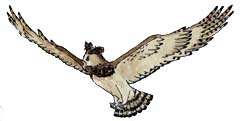

They are found in Central America down to South America.
They live in forests.
A very large eagle, it can grow to 3.5 feet tall. They have a dark gray back and wings, a white chest and belly. There is a black band across the upper chest. They have a gray head with a large crest.
They have short wings for flying in the forest but can reach speeds of 50mph in flight. They are known for weaving in and out of the forest hunting prey.
They eat opossums, sloths and monkeys.
They build a large nest of sticks high up in a tree or on a cliff edge. Females lay 1 – 2 eggs. They seem to mate for life (monogamous) and both parents care for the young.
Kingdom: Animalia
Phylum: Chordata
Subphylum: Vetebrata
Class: Aves
Order: Falconiformes
Family: Accipitridae
Subfamily: Accipitrinae
Genus: Harpia
Species: H. harpyja
When you research information you must cite the reference. Citing for websites is different from citing from books, magazines and periodicals. The style of citing shown here is from the MLA Style Citations (Modern Language Association).
When citing a WEBSITE the general format is as follows.
Author Last Name, First Name(s). "Title: Subtitle of Part of Web Page, if appropriate." Title: Subtitle: Section of Page if appropriate. Sponsoring/Publishing Agency, If Given. Additional significant descriptive information. Date of Electronic Publication or other Date, such as Last Updated. Day Month Year of access < URL >.
Amsel, Sheri. "Eagle (Harpy)" Exploring Nature Educational Resource ©2005-2024. December 15, 2024
< http://www.exploringnature.org/db/view/Eagle-Harpy >

